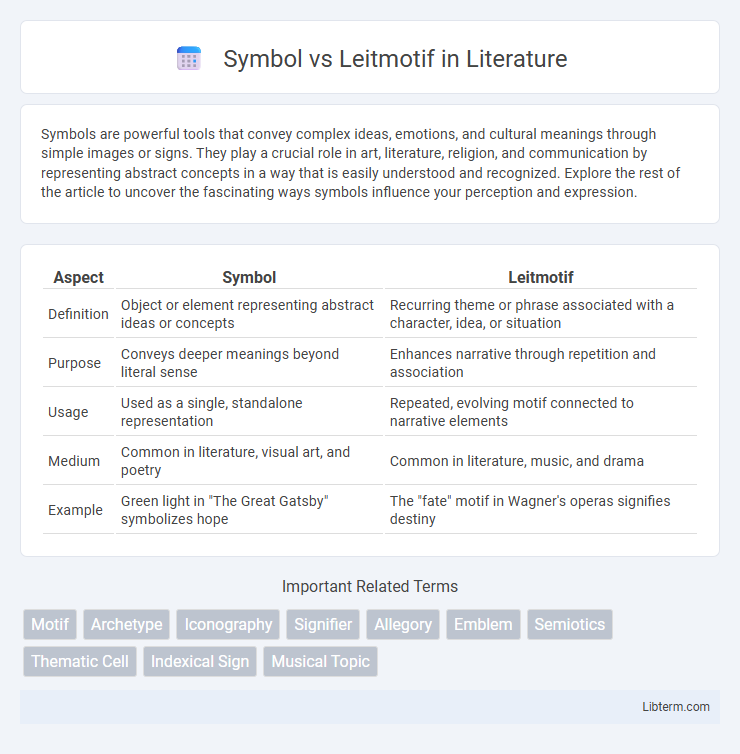Symbols are powerful tools that convey complex ideas, emotions, and cultural meanings through simple images or signs. They play a crucial role in art, literature, religion, and communication by representing abstract concepts in a way that is easily understood and recognized. Explore the rest of the article to uncover the fascinating ways symbols influence your perception and expression.
Table of Comparison
| Aspect | Symbol | Leitmotif |
|---|---|---|
| Definition | Object or element representing abstract ideas or concepts | Recurring theme or phrase associated with a character, idea, or situation |
| Purpose | Conveys deeper meanings beyond literal sense | Enhances narrative through repetition and association |
| Usage | Used as a single, standalone representation | Repeated, evolving motif connected to narrative elements |
| Medium | Common in literature, visual art, and poetry | Common in literature, music, and drama |
| Example | Green light in "The Great Gatsby" symbolizes hope | The "fate" motif in Wagner's operas signifies destiny |
Understanding Symbols and Leitmotifs
Symbols represent objects, characters, or events that convey deeper meanings beyond their literal sense, often embodying abstract ideas or themes within a narrative. Leitmotifs are recurring musical phrases or motifs linked to particular characters, themes, or emotions, used to reinforce narrative elements and evoke specific responses in audiences. Understanding symbols and leitmotifs involves recognizing their distinct roles in storytelling: symbols enhance thematic depth, while leitmotifs create emotional continuity through repetition and association.
Defining Symbols: Meaning and Usage
Symbols function as tangible or visual elements that represent abstract ideas or concepts, providing layers of meaning within a text or artwork. They serve to evoke emotional responses and enrich interpretation by linking concrete objects to larger themes or cultural significance. Unlike leitmotifs, which primarily use repeated musical or thematic elements to signify characters or ideas, symbols encompass a broader range of representational forms across various media.
What Is a Leitmotif? Origins and Applications
A leitmotif is a recurring musical theme associated with a particular character, idea, or situation, originating from Richard Wagner's operas in the 19th century. It functions as a narrative device in film scores, theater, and literature to signal emotional and thematic connections. Unlike a symbol, which is a broader representational element, a leitmotif specifically uses auditory motifs to evoke recognition and deeper storytelling layers.
Key Differences Between Symbols and Leitmotifs
Symbols represent abstract ideas or concepts through objects, actions, or images that carry deeper meaning beyond their literal sense, often consistent across various contexts. Leitmotifs are recurring musical themes associated with a particular character, idea, or situation, primarily used in operas, films, and literature to evoke emotions and reinforce narrative elements. The key difference lies in symbols serving as visual or thematic metaphors conveying wide-ranging interpretations, while leitmotifs function as repeated auditory cues that provide cohesion and thematic recognition within a work.
Symbolism in Literature and Art
Symbolism in literature and art employs objects, characters, or colors to represent abstract ideas, evoking deeper meanings beyond their literal sense. Unlike leitmotifs, which are recurrent musical or thematic phrases tied to specific characters or themes, symbols function as standalone elements that convey universal concepts or emotional resonance. This strategic use of symbolism enriches narrative layers, fostering interpretative engagement and highlighting cultural or psychological dimensions within creative works.
Leitmotif in Music, Film, and Storytelling
Leitmotif is a recurring musical or thematic phrase associated with a particular character, idea, or situation, used extensively in music, film, and storytelling to enhance narrative cohesion and emotional impact. In Wagnerian opera, leitmotifs function as sonic symbols that guide audiences through complex plots by signaling characters or themes without explicit exposition. Film composers like John Williams utilize leitmotifs to create memorable associations that deepen audience engagement and support story development through musical continuity.
Psychological Impact of Symbols vs. Leitmotifs
Symbols evoke deep psychological responses by triggering universal archetypes and subconscious associations that shape individual perception and emotional resonance. Leitmotifs enhance cognitive recognition and emotional continuity by linking specific musical themes to characters or ideas, reinforcing memory and emotional engagement throughout a narrative. The psychological impact of symbols is often broad and interpretive, while leitmotifs provide focused, recurring cues that guide audience interpretation and emotional reaction with precision.
Functions and Effects in Narrative Structure
Symbols function as tangible elements representing broader abstract ideas, enriching narrative depth by allowing multiple interpretations and evoking emotional resonance. Leitmotifs serve as recurring musical or thematic motifs, reinforcing character identities, themes, or emotional states, thereby enhancing narrative cohesion and aiding audience recognition. Both devices contribute to layered storytelling by embedding meaning that guides viewer perception and underscores thematic continuity within the narrative structure.
Famous Examples: Symbols and Leitmotifs in Popular Culture
The symbol of the "Mockingbird" in *To Kill a Mockingbird* represents innocence and moral integrity, while the leitmotif of Darth Vader's theme in *Star Wars* is a recurring musical phrase embodying the character's darkness and power. In *The Great Gatsby*, the green light serves as a symbol of hope and unattainable dreams, contrasting with the leitmotif of the Joker's manic laugh in *The Dark Knight*, which underscores chaos and unpredictability. These examples illustrate how symbols convey deeper meanings visually or thematically, while leitmotifs use repetition in music or sound to reinforce character identity and emotion.
Choosing Between Symbol and Leitmotif: Creative Considerations
When choosing between symbol and leitmotif, creators weigh the depth of abstraction against narrative repetition. Symbols encapsulate broad, often multifaceted ideas in a single image or object, allowing for varied interpretation, while leitmotifs provide recurring musical or thematic elements that reinforce character identity or plot development throughout a work. The decision hinges on whether the intent is to evoke interpretive thought through imagery or to create psychological resonance via repeated thematic cues.
Symbol Infographic

 libterm.com
libterm.com